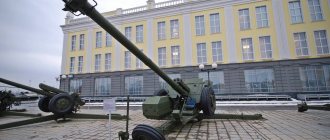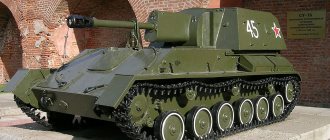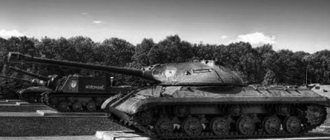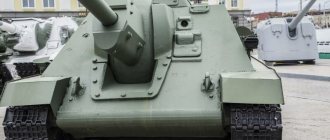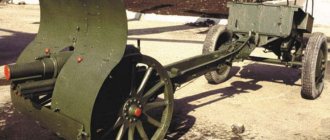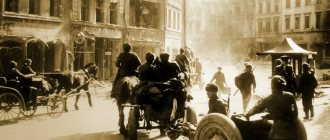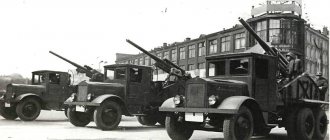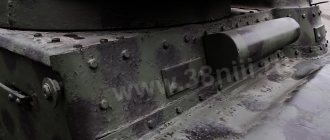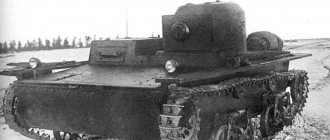| This article includes a list of common references, but it remains largely unverified because It lacks a sufficient number of relevant embedded links . |
Type of self-propelled anti-tank gun
| 17pdr SP M10 "Achilles" | |
| M10 Achilles self-propelled anti-tank gun with the characteristic long-barreled high-velocity British 17pdr, at La Roche-en-Ardenne, Belgium | |
| Type | Self-propelled anti-tank gun |
| Place of origin | United Kingdom |
| Production history | |
| Manufacturer | Fisher Tank Arsenal Grand Blanc, Michigan - converted by Royal Arsenal, Woolwich |
| No built | 1,100 |
| Characteristics | |
| Weight | 29.6 tons (65,000 lb) |
| Length | 7.01 m (23 ft 8 1 ⁄ 4 in) with pistol 5.97 m (19 ft 7 in) without pistol |
| Width | 3.05 m (10 ft) |
| Height | 2.57 m (8 ft 2 in) |
| Crew | 5 (commander, loader, gunner, assistant loader, driver) |
| Armor | 9 to 57.2 mm (0.3 to 2.3 in) |
| Main weapons | Ordnance QF 17 pounder (76.2 mm) 50 rounds |
| Secondary weapons | 0.50 cal (12.7 mm) Browning M2HB A.A. Machine gun 420 rounds 0.303 (7.62 mm) Bren machine gun [1] |
| Engine | Diesel General Motors 6046 (twin 6-71) 375 hp. (276 kW) |
| Power/weight | 12.5 hp / ton |
| Suspense | Vertical Volute Spring Suspension (VVSS) |
| Operating range | 300 km (186 mi) |
| Maximum speed | 51 km/h (32 mph) |
17pdr SP Achilles
(officially
17 pounder, Self Propelled Achilles
) was a British variant of the American M10 self-propelled gun armed with a British Ordnance QF 17 pounder high velocity 76.2 mm (3 in) anti-tank gun in place of the M10 significantly less powerful 3 in (76.2 mm) M7 gun . A total of 1,100 M10s were converted to Achilles, making it the second most numerous 17-pounder armored fighting vehicle after the Sherman Firefly.
The name "Achilles" was the official designation for both the 3-inch and 17-pound versions (as Achilles I/II and Achilles Ic/IIc respectively), but saw little use during World War II; at that time the machine was called 17pdr M10, or 17pdr SP M10, or even sometimes "Firefly". Since then it has become identified almost exclusively with the 17-pound version.
Origins[edit]
After the successful German campaigns of 1939–41. US armor doctrine included the idea of fast, lightly armored vehicles carrying high-velocity anti-tank rifles as the best way to deal with the fast-moving armored spearheads of the German Blitzkrieg. The M10 was based on the M4 Sherman chassis, but had thinner but more sloped armor to meet the tank's high speed requirements. At the same time, the British were exploring the possibility of developing a low-body self-propelled tank destroyer, preferably with a 360-degree rotatable turret, with armor capable of resisting the German 5 cm KwK 39 standard 50 mm gun at 800 yards and mounting a 17-pounder gun. However, with the appearance of the M10 on the battlefield in late 1942, British plans for a turret-mounted self-propelled gun were canceled.
The M10 armor provided good protection against the 50 mm gun mounted on most German tanks and anti-tank guns. The M10 first became available to the British in 1943. These vehicles were open-topped and fitted with the 3-inch (76.2 mm) American M7 gun, which was significantly more powerful than the 6-pounder Ordnance QF gun that was fitted to British tanks of the type of the period and had equal power to the 7. 5 cm KwK 40, used on Panzer IV and Sturmgeschütz III.
TTX Achilles
Perhaps we should start with the fact that we have at our disposal a very decent safety margin for a level 6 tank destroyer, as well as an excellent basic viewing range of 370 meters, which is very pleasing.
However, the Achilles heel of our Briton can rightfully be considered its survivability parameters. The first thing that immediately catches your eye when you see this self-propelled gun is the Achilles tank
has a bloated and tall silhouette, that is, our dimensions are quite barn-sized, which is why the camouflage is not the best.
At the same time, things are no better with bookings. Let's start with a very large hull and everyone will penetrate us into the frontal projection; even tanks of the fifth level do not have difficulties with this. The thing is that even with a good slope, Achilles has characteristics
VLD reservations do not exceed 68 millimeters.
With the turret the situation is not much better, since the large gun mantlet, even taking into account small inclinations, has a reduced thickness of about 82 millimeters, behind it we have emptiness, that is, to penetrate the Achilles tank
It won't be difficult even for level 5s to hit it head-on.
Unfortunately, in our case there is nothing to say about the sides. Even at an angle, the frail 24 millimeters in the side of the hull are easily penetrated, the turret is almost the same in thickness on the side, and we should especially be wary of landmines, because they will most likely cause full damage to us.
However, among all this variety of mediocrity, it also has a strong side - driving performance. This means that the maximum speed of the self-propelled gun is good, the dynamics are absolutely remarkable, and maneuverability is at a very decent level.
Design[edit]
An Achilles 17pdr self-propelled anti-tank gun crossing the Savio River in a Churchill ARK which was shot down into the river, 24 October 1944.
The 17-pdr SP Achilles was a modified M10, the main difference being the gun. The Achilles' main armament was the 17-pounder Ordnance QF gun, significantly more powerful than the 3-inch (76.2 mm) M7 gun mounted on the standard M10. The single top-mounted M2 Browning .50 caliber heavy machine gun was retained.
The 17-pounder gun mounted on the Achilles could penetrate about 140 mm of armor at 500 m (550 yd) and 131 mm at 1,000 m (1,100 yd) using standard armor-piercing, sealed, ballistic (APCBC) ammunition striking at 30 degrees corner. When supplied, the armor-piercing sabot (APDS) ammunition could penetrate about 209 mm (8 in) of armor at 500 m and 192 mm at 1,000 m at 30 degrees, although the APDS round's accuracy was poor during the war. By comparison, the M7 cannon on a standard M10 using the same type of ammunition (APCBC) penetrated 98 mm of armor at 500 meters at a 30 degree angle and 88 mm of armor at 1000 meters at a 30 degree angle. Only high velocity armor piercing (HVAP) ammunition compared this gun to the 17 pounder: the ammunition could penetrate 140 mm at 500 m at 30 degrees and 127 mm at 1000 m at 30 degrees. However, HVAP ammunition was in very short supply, whereas standard 17-pounder ammunition was available in huge quantities to the British.
The 17-pounder gun required a counterweight mounted behind the muzzle brake on its long barrel. This gave the Achilles a distinctive appearance compared to the comparatively short-barreled, unbraked and completely straight barreled M10. Once the Germans discovered the effectiveness of the Achilles gun on the same M10 carriage as the much less powerful M7 gun, attempts were made to camouflage the 17-pounder by painting its brake and counterweight.
Two other material changes were made to the Achilles: the addition of 17 mm (0.67 in) thick armor plates welded to the front and sides of the M10 to increase armor protection, and the M10's exposed turret was fitted with a 20 mm thick shield to provide protection against overhead threats . [ citation needed
]
Advantages and disadvantages
When playing any tank in our game, it is extremely important to understand its main strengths and weaknesses, because tactics in battle are built on this knowledge. Of course, everything has already been said in the analysis of the general characteristics and parameters of the gun, but for greater clarity it is better to highlight the advantages and disadvantages of Achilles WoT
separately. Pros: Excellent review rate; Good mobility; High rate of fire and DPM; Decent penetration parameters; Good accuracy; The presence of a fully rotating tower. Cons: Poor booking; Barn-like dimensions and rather weak camouflage; Little Alphastrike; Poor elevation angles.
Production[edit]
German troops inspect an Achilles from 245 Battery, 62nd Regiment Royal Artillery, knocked out by three penetrating turret hits in Normandy, 1944.
Tank destroyer Achilles 17-pdr uses a building as cover at Hassum, near Hoch in Germany, 20 February 1945.
The desire to install a 17-pounder gun on the M10 was due to the degree of difficulty of installing a 17-pounder gun on the tank itself. Fortunately for the British, the first batches of the M10 had an easily modified gun mount to facilitate future replacement of the old M7 3-inch gun with the new M1 76 mm gun. This gun mounting design allowed the British to replace the 3-inch gun with a 17-pounder gun. In 1943, the British received about 845 vehicles, but of the second version of the M10, only the T71 brand, designed to mount the M1 gun, could carry a 17-pounder gun. [2]
The British planned to convert about 1,000 M10s into 17-pounder armed variants for Normandy, but for some reason conversion did not begin until April 1944. Only about 124 M10s had been converted by D-Day; however, the number of converted vehicles increased after D-Day, and by the end of the year 816 M10s had been converted, 152 units in November alone. However, the small numbers on D-Day meant that many British units came ashore with standard M10s, and casualties in Achilles units were often replaced by standard 3-inch M10s.
As a self-propelled anti-tank gun, both the Achilles and standard M10s were distributed and operated by Royal Artillery regiments. Some 1,650 M10s were received by the British during the war, of which 1,100 were converted to 17 pdr by the end of the war.
Playing style.
Achilles is a universal vehicle that can easily move around the battlefield and support an attack, return to shoot down a capture or cover a flank. The hole-punch weapon does not pose a dangerous threat from one shot of 150 units, but with its rate of fire, the damage per minute reaches 2000 points, and this is more than the durability of any vehicle that Achilles encounters in battle.
An assault in the front ranks is not the best idea, since our anti-tank gun will burst even from a landmine, especially from high-level vehicles. We build a battle behind our brothers, cover the flanks, support the attack and shoot damage before they pay attention to us, then we move, disappear “from the light” and repeat the maneuver.
Operational use[edit]
The standard anti-tank gun used by British Army infantry units was the 6-pounder, a small lightweight gun capable of defeating the more conventional German Panzer IVs and Sturmgeschütz with conventional ammunition, but not the heavier Panthers and Tigers. The next generation British gun, the 17-pounder, could deal with Tigers and Panthers, but had a much longer pre-battle setup time than the 6-pounder due to its larger size, often requiring a day to fully prepare for battle.
As a result, the British used the Achilles as a rapidly deployable anti-tank gun, capable of reinforcing a position occupied by infantry and counter-attacking German forces, while the slower towed 17-pounder guns were picked up and dug in for longer periods. term protective presence. This had the advantage of weakening Achilles' weak armor protection, as using it defensively would usually allow him to fire the vital first shot. This was consistent with the original design concept of the vehicle, designed to weaken the German Blitzkrieg attack tactics. The M10/Achilles turret had an exceptionally slow manual turret traverse, which was a limited tactical disadvantage when the tank was only used for defensive purposes. Thus, they had an advantage over the German Stugs, which did not have a turret rotation. However, the Stug's low profile and heavy armor were important assets that allowed it to succeed in a variety of tactical environments. Typically the British used M10s and Achilles in the attack only in support of Churchill's tank units, which lacked the associated 17 PDR tanks that Sherman and Cromwell's tank units had.
Achilles came ashore on D-Day, equipping units of the Royal Artillery and Royal Canadian Artillery in armored divisions or corps anti-tank regiments. A typical aviation regiment will have 4 batteries, 2 towed 17 pounder batteries, 1 Achilles battery and 1 M10 battery. The M10 battery was replaced by a second Achilles battery when more vehicles became available. Perhaps the most successful Achilles action was carried out by B Troop of the 245th Battery, 62nd Anti-Tank Regiment, Royal Artillery, attached to the Royal Hamilton Light Infantry during Operation Charnwood. South of Buron, a counterattack by a mixed force of Panzer IV and Panther tanks. The 12th SS Panzer Regiment was routed by Achilles and the 17-pounder anti-tank guns of the 245th Battery of the 62nd Anti-Tank Regiment. Thirteen German tanks were destroyed in one of the most successful anti-tank battles of the campaign: four self-propelled guns were lost and four more were damaged. [3]
Achilles with an iron heel
The British armored weapon system found itself in a rather strange position at the beginning of World War II.
The country that was the first to invent self-propelled artillery units was left completely without vehicles of this class. Attempts to catch up with other powers were unsuccessful. For artillery support of the infantry, the Bishop was quickly built Valentine Sextons and the Americans with their Priests . With tank destroyers, the situation was even worse: while the Bishop turned out to be a mediocre, but quite combat-ready vehicle, the Churchill Carrier was a shame to show off in polite society. We had to again rely on foreign supplies, while the received American tank destroyers were modified in the UK. This will be discussed below .
Fast fighter
The US military developed a new tank destroyer concept in the early 1940s after studying German tactics in the French campaign of May-June 1940. Mobility was recognized as the main feature of anti-tank battalions, although at first they were armed only with 37-mm guns towed by jeeps. Already the battles in North Africa in 1941 showed that such a gun would not be enough to fight the latest enemy tanks.
Assembly of the M10 tank destroyer
In 1942, production of the more powerful 57 mm M1 gun, copied from the British 6-pounder, began production, but the American military reacted coolly to this gun. For their own needs, a 76-mm cannon with the ballistics of an anti-aircraft gun of the 1918 model was developed, but here the Americans faced the same problem as other armies that adopted anti-tank guns of the 75-76 mm class - high mass. The three-inch gun weighed almost twice as much as the 57-mm gun, and moving it across the battlefield with crew forces became quite difficult. It was also impossible to tow the gun with a light and mobile “jeep”, and the M3 half-track armored personnel carrier was used as a tractor.
Like others who encountered this problem, the Americans solved it by installing a heavy gun on a self-propelled chassis. On the chassis of the rather successful Sherman, namely its diesel version M4A2, the Americans received an experienced T54E1 tank destroyer with a rotating turret open on top. Compared to the original tank, the armor was weakened, but this was not considered a big problem, since mobility was the priority. In June 1942, the American Ordnance Department recommended that the vehicle be accepted into service, and in September 1942 it was standardized under the designation Gun Motor Carriage M10.
The tank destroyer on the Ram chassis was visually not too different from the American car
The British Commonwealth learned about the new tank destroyer in the spring of 1942. Seeking a "first-class tank destroyer" for its allies, the Canadian military turned to the United States in May 1942. They were told about the T54E1, but the Americans had no intention of supplying such vehicles to the troops or even providing a copy for testing. A compromise was found. Canada was already producing its own medium tank. The Ram, like the Sherman, was created on the basis of the American Medium Tank M3, so building the M10 on a Canadian tank chassis was not seen as a big problem. The Americans promised to supply a gun, a turret, a turret ring and a set of drawings. The Canadian side supplied the Ram tank, armor for the prototype and funds for modifications.
On September 3, 1942, 75,000 Canadian dollars were allocated for the project. However, the availability of funding did not mean that the project would be successfully completed. Unlike the artillerymen, the Armaments and Supply Department did not show much enthusiasm for the Canadian-American hybrid, believing that the country's higher priority was the development of the Sexton and a 3.7-inch anti-aircraft gun on the Ram tank chassis. Therefore, the T35E1, which arrived on the turret, collected dust for almost two months before work on the tank destroyer began.
Ram 3-inch SP rear view. The R-975 engine is visible through the open hatch
Luck again bypassed the project, designated as a 3-inch self-propelled gun on the Ram chassis (Ram 3-inch SP), bypassed. It turned out that the turret ring, rotation mechanism and lifting mechanism obtained from the Americans were worn out to such an extent that they were virtually unusable. The turret had to be returned to Detroit, where the gun was refitted into a production M10 turret and shipped back to Canada. The exchange cost the Canadian government $22,000. Finally, on December 11, 1942, the new turret was installed on the hull. As with the M10, the Ram's chassis was not left in its original form. The cast top of the hull was replaced with a welded structure, just like the American self-propelled gun. Unlike the diesel M10, the Canadian self-propelled gun was assembled on a chassis with an R-975 gasoline engine.
The Canadian version of the M10 tank destroyer was sent to the Petawawa artillery range, where testing began on December 29. Despite the bad weather, in which it was completely impossible to use a telescopic sight - the effective aiming distance using a panorama did not exceed 1000 yards or 917 meters - the gunners gave the go-ahead to the self-propelled gun. On January 7, the car returned to the factory, where it was prepared for shipment to the UK. On February 6, a Canadian M10 departed Halifax.
The vehicle arrived at the British test site on April 5, testing began on April 21 and ended on May 5. British gunners criticized American decisions. The turret turned out to be unbalanced, which made it impossible to aim it at a roll of more than 10°. There was no turret rotation motor. The British installed an auxiliary turret rotation flywheel for the commander, but this was only a half-measure. The tank was equipped with a turret rotation motor, removed from the Ram tank, as well as an 860-kg counterweight, but this solution also turned out to be unsatisfactory. The British also did not like the optics: in their opinion, the American sights should be replaced with domestic ones, and also a periscope should be added to the commander so that he could observe the battlefield without leaning out of the turret.
Against the backdrop of harsh criticism of the Canadian design, it looks rather strange that the British adopted the M10 into service, and by the end of the year 845 of these tank destroyers arrived in the UK, and by the end of the war - already 1648. The self-propelled gun was given the name “Achilles”. Vehicles with an early turret were called "Achilles" Mk.I, and later ones, with a more balanced turret, were called "Achilles" Mk.II. The name did not catch on among the troops, and in documents the self-propelled gun was simply called M10 or 3-inch SP M10.
Ram 3-inch SP front view. WE-210 headlights and tracks are of Canadian origin.
The British artillerymen were right in many ways: the M10 turned out to be very far from ideal and indeed had many shortcomings. Alas, they didn’t have much choice. The Challenger's own, although it had a more powerful 17-pounder gun, raised at least as many questions. In May 1943, artillerymen were shown a prototype of a tank destroyer on the Valentine chassis, into which, at the cost of a rather unusual layout, they managed to squeeze a 17-pounder. But this car also needed to be improved, but the M10 could be ordered right now. However, this did not mean that the British were going to put up with the defects of the American design. In addition to the routine elimination that all American cars went through, Achilles began to be prepared for a much more serious modernization.
Others 76 mm
The project called “17-pdr. Mk.II gun in M-10 Chassis" first appeared in correspondence by the beginning of September 1943. Initial analysis already indicated that a counterweight would have to be installed in the turret due to the increased weight of the gun. Unlike the Sherman, in which this function was performed by a box for the radio station, steel blocks had to be welded on the M10, although an option was also described in which the role of a counterweight was played by an ammunition rack for 18 shots, protected by 40 mm armor.
Brand new M10s in Detroit, 1943. The Canadian ersatz was never needed, American tank destroyers were enough for everyone
By December 15, the British began the conversion, for which they chose a vehicle with a late turret, nicknamed the “duck beak.” In order for the 17-pounder to fit into the rig, the cradle had to be trimmed slightly. It was also necessary to make a new mask, since after installing the British cannon in it, there was a gap 1.5 inches wide. Some calculations had to be done again, since the muzzle brake on the gun allocated for conversion weighed 45 pounds (20.4 kg) instead of the calculated 35 pounds (15.9 kg). The gun was also modified, since in its original form it did not fit in the turret. The trigger mechanism was placed above the cradle and the automation was replaced. Along with the gun, the sighting devices were also replaced: the 17-pounder could be aimed at the target using artillery sight No. 9, clinometer Mk.IV, telescopic sight No. 51 and alidade.
The combat weight of the new vehicle without a crew reached 28.4 tons. Unlike the 17-pounder Sherman, which was noticeably heavier compared to the original vehicle, the M10 survived the conversion much more easily. The overall length of the vehicle increased by literally half a meter and was 24 feet 2 inches (7366 mm) with the gun in the forward position or 24 feet (7315 mm) with the turret turned rearward. The height and width of the car remain the same. Unlike the Firefly, the composition of the crew did not change: it included a driver, an assistant driver (also a radio operator, since radio station No. 19 was installed in the hull, and not in the turret), commander, loader and gunner. The British decided that, if necessary, one more crew member could be placed in the car.
The infantry rides on the armor of the Achilles. The characteristic muzzle brake and counterweight of the 17-pounder are clearly visible in the frame.
The conversion did not take much time, and the first firing tests took place on December 23. A total of 10 shells were fired. Test results were mixed. On the one hand, the concept worked, no major defects appeared, and the testers found no traces of deformation. On the other hand, the recoil length was insufficient for the automatic operation, and the knurling mechanism sent the gun forward too sharply. The installation itself also needed to be modified, since the gun in it rotated when firing.
The modified automation was tested again on January 19. When firing armor-piercing shells, the mechanism worked satisfactorily until the 40th shot, after which the roll of the barrel turned out to be incomplete. The cannon also fired high-explosive fragmentation shells. The automation worked satisfactorily only at an initial projectile speed of 2300 feet (700 meters) per second or more, which gave a recoil of 9.8 inches (250 mm). By this time, not only the automation mechanism had changed: from January 14, the project began to be called 17-pdr. M10 SP: 17-pounder self-propelled gun on the M10 chassis.
Far from Troy
The design was considered combat-ready by March, and the project was closed by the Department of Tank Design (DTD). However, the topic still needed some work. The army praised the project and ordered 1,000 vehicles, but by May 1944 it became clear that only 100 of them would be ready for the Normandy landings. According to the English system, vehicles with a 17-pounder received the letter “C” in the designation: “Achilles” with the old turret were called Mk.IC, and with the new one - Mk.IIC. However, such an index was practically not used in correspondence, and among the troops the vehicle was mainly called simply “17-pound M10” (17-pdr. M10).
"Achilles" with a makeshift roof on the road to Coesfeld, West Germany, March 30, 1945
At the front, Achilles with both the 76-mm gun and the 17-pounder were concentrated in the anti-tank regiments of the armored divisions. Also, as an anti-tank reinforcement, the M10 group could be given to a battalion or regiment of Churchills, since even the heavily armored Churchill Mk.VII had a 75-mm cannon, similar to that on the American Sherman. The ammunition they carried spoke volumes about what the self-propelled guns were intended for: M10s with 76mm cannons had 19% of M62 armor-piercing rounds (APC) rounds, 48% of M79 armor-piercing rounds, and only 33% of high-explosive rounds.
In the event of a shortage of any type of ammunition, the deficiency was made up by shots with armor-piercing shells. The M10's 17-pounder, which had an even less effective high-explosive round, therefore placed even more emphasis on armour-piercing rounds: 85% of shots fired with the armor-piercing round with armor-piercing and ballistic tips (APCBC) and only 15% with high-explosive rounds. Tank destroyers quickly proved their worth in combat. For example, on July 8, 1944, in a collision with German tanks from the 12th SS Panzer Division, the Achilles from the 10th Armored Regiment destroyed 13 of them (in some sources the opponents of the M10 are called “Panthers”) at the cost of four destroyed and four damaged M10s.
To protect the fighting compartment from above, front-line units developed their own roofs, which were different from each other. This roof was designed by repairmen of the 12th Armored Corps
Self-propelled tank destroyers turned out to be much more effective than towed 17-pounder guns, since they moved into firing positions too slowly. As we moved deeper into France, the reputation of self-propelled guns only grew, as it turned out that the Panthers would not be a rare enemy like the Tiger, used as part of special units, but a rather ordinary medium tank. The 17-pounder was capable of penetrating the thick frontal armor of the Panther's hull, and the 76-mm cannon could hit its gun mantlet with armor-piercing shells.
High-explosive fragmentation shells were also useful. For example, an armored report from the Mediterranean theater from February 1945 described an incident in which an M10 platoon encountered a German self-propelled gun that was able to knock out three of five British tank destroyers. The remaining two hid behind buildings, in the walls of which they made loopholes with high-explosive fragmentation shells. Shooting from cover, the surviving crews were able to knock out the Germans.
Diagram of the roof structure of the 62nd Anti-Tank Regiment
However, self-propelled guns had their drawbacks. Mostly, the crews complained about weak protection. While the sides, stern and forehead were protected from bullets and shrapnel, the crew in the turret sat in the open air and were often hit from above. Ammunition was also supplied during the laying of the first stage. This deficiency led to the development of roofs that were installed in the field. Since the solution was improvised, the designs differed from each other. For example, in the 8th Army they welded an impressive 20 mm thick roof, in which hatches were cut out. The hatch doors were only 9 mm thick, since ease of opening was rightfully considered more important than uniform armoring. The 21st Army Group developed its own 10 mm thick roof. Five hatches were cut into the roof: three for the entry and exit of the crew, two for firing from an anti-aircraft machine gun.
To provide visibility, the roof was mounted 11 inches (28 cm) above the tower. Mild steel reflectors were welded to it to prevent bullets and fragments from ricocheting inside. A similar design, assembled from half-inch (12.7 mm) plates, was invented in the 5th Army. However, not all officers agreed with the need for such a modification. According to many artillerymen, installing a roof on a self-propelled gun is nothing more than an attempt to create an ersatz tank, after which such vehicles will be taken by tankers. But even if the M10 manages to survive, it’s not worth sacrificing visibility for additional protection. To be fair, it is worth noting that the arguments against additional protection came from senior commanders who did not personally fight in open towers.
Another roof option
Installing the roof wasn't the only modification to the car made in the field. For example, in some units they added an additional stowage for 30 rounds for the gun under the breech, bringing the Achilles’ ammunition load to 84 rounds.
Predictably, it turned out that the M10 suffers from all the ailments typical of Shermans - for example, rapid wear of the road wheel tires and tracks. New problems also appeared - for example, the muffler protection grilles were removed when installing equipment for fording or a tow hook, after which the exhaust fumes flew straight into the face of the crew of the vehicle following the M10. The exhaust was thick, and the crews were afraid that it would give them away on the march.
However, some commanders did not consider this a significant drawback. In their opinion, due to the presence of a silencer, the M10 could operate much more covertly than the M36 Jackson/Slugger. It was possible to safely move in close proximity to one’s own infantry without attracting enemy fire. The absence of a turret basket, which some consider to be a disadvantage of the Achilles, was welcomed by the gunners, since without it all five crew members could sleep on the floor of the fighting compartment.
"Achilles" crossing the Savio River in Northern Italy on the Churchill Arch bridge, 1944. A broken Panther is visible on the left.
Unlike the Shermans, the M10 did not have an auxiliary motor for the generator, and charging the batteries required the use of engine life. The crews also did not like the lack of shielding of ammunition racks, which had already been carried out on the Shermans by this time.
M10 self-propelled guns made up the majority of British tank destroyers in northwestern Europe and Italy even after the Archers began to enter service. A survey conducted in Italy at the end of 1944 indicated that artillerymen were satisfied with their vehicles. The Achilles received fewer complaints than the Archers, and the shortcomings turned out to be less significant. Parts were easier to obtain for the M10, and crews valued the interchangeability of parts with the tanks they interacted with, as well as the ability to move with one damaged engine. In addition, sometimes infantrymen confused the silhouette of the Archer with German tank destroyers, so fighting on the Achilles was considered safer from the point of view of friendly fire.
"Achilles" at the Tank Museum in Bovington, UK
"Achilles" showed its best side at the front. Like the Sherman Firefly, these vehicles became formidable opponents for the German menagerie. However, if in the case of the Sherman, tankers sought to either place a 17-pounder in a larger turret, as on the Centurion or Black Prince, or put a smaller gun in a turret of acceptable dimensions, as on the Comet, then the self-propelled guns, Apparently, they were satisfied with their Achilles. The vehicle was never replaced by anything until the end of the war, and the M10 can easily lay claim to the title of the best British tank destroyer of the Second World War.
Sources:
- Archive Canadian Military Headquarters, London (1939–1947), RG 24 C 2
see also
- link to the family of equipment;
- links to approximate analogues in other nations and branches.
- topic at the office game forum;
- Wikipedia page;
- page on Aviarmor.net;
- other literature.
Achilles is a British tier 6 tank destroyer, added in patch 0.9.5.
The English modification of the American M10 tank destroyer underwent a standard modification by installing an English gun.
Achilles game tactics
Based on the totality of the advantages and disadvantages of this device, we can say that we have a very strong machine in our hands. Of course, it requires a special approach, but remembering the weak armor and large dimensions, tactics for Achilles
An ambush, so to speak, typical of many tank destroyers, is more suitable.
Thus, at the very beginning of the battle, make sure to take a position in the bushes on the second line as quickly as possible. Here it will be more difficult to detect you, and accordingly, implement the DPM of a rapid-fire gun, which the Achilles tank
, it will be much easier and safer.
When taking a position, remember about poor elevation angles, that is, the area on which you will stand must be more or less level. Standing in the distance tank destroyer Achilles WoT
is capable of very effectively shooting damage at allied light, an accurate weapon will help you with this. This way, you can provide serious assistance to your team.
As for close combat, it is better not to engage in it at all, because anyone can penetrate us. For this reason, the player on Achilles World of Tanks
must constantly monitor the mini-map and in case of danger, it is better to take advantage of your excellent mobility and leave as quickly as possible, perhaps even change flank.
In special cases, we can act as a medium tank, highlighting enemy positions for allied vehicles. But be extremely careful, move gradually and even in such cases, try not to glow. Especially the Achilles tank
vulnerable to land mines, so we need to be afraid of artillery and monsters like the KV-2.
Review
Achilles is another car that has benefited from British tuning. And it’s not just the replacement of the gun and the addition of hit points (which, by the way, made the Achilles the third easiest, after the AT8 and Churchill GC), the car noticeably frolic, and so much so that the English M10 dangles faster than the English Sherman.
In my opinion, it is on this vehicle that the 17-pound cannon is fully revealed: the aiming and rate of fire parameters are better only in the PT-7, but at the same time we have the most comfortable range of combat levels. In general, the British conversion of the M10 turned out to be a very, very good tier 6 tank, something between a Jackson and a Hellcat.

